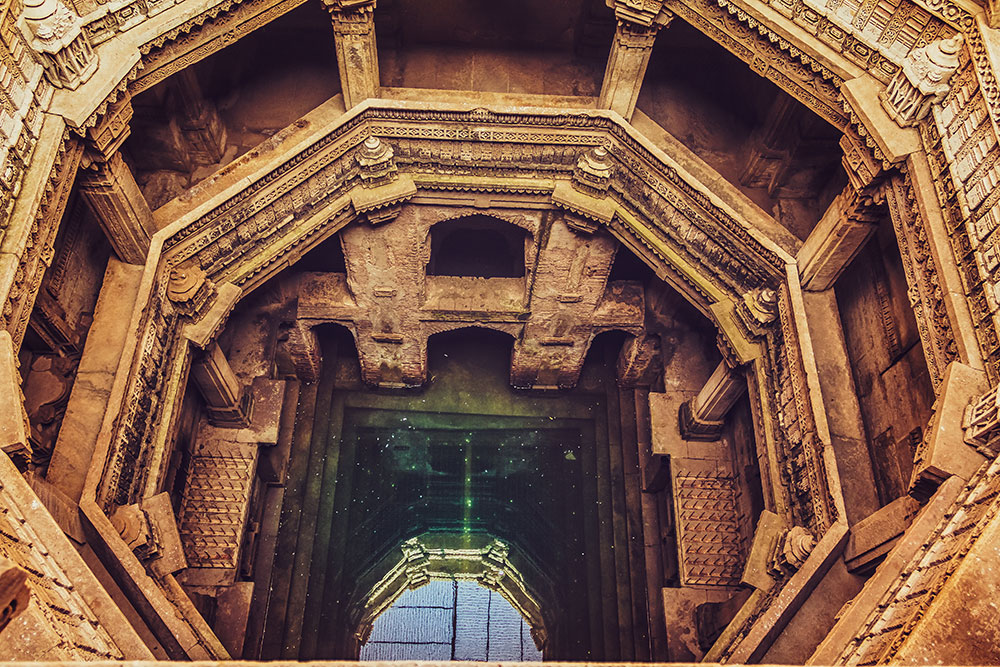Adalaj ki vav: Always say yes to new adventures.Journey. Explore. Discover & Repeat.
The Adalaj stepwell or 'Vav', as it is called in Gujarati, is intricately carved and is five stories deep. It was built in 1498. An inscription in Sanskrit establishes the history of the Adalaj stepwell found on a marble slab positioned in a recess on the first floor, from the eastern entry to the well.
With a population of more than 4.5 million people, the city of Ahmedabad is the business junction of Gujarat. The city situated on the banks of Sabarmati was founded by Sultan Ahmed Shah and has been ruled by several rulers.It is also renowned for its plethora of historical monuments that gives an insight into its rich culture and heritage. Ahmedabad is ornamented with step wells and the most prominent among them is the Adalaj Step Well which is also popular as Adalaj ni Vav.
Visitors would feel history as they step down the step well with its cool ambiance and colossal architecture. Visiting the historic monument is a captivating experience especially for history buffs. The spectacular edifice was often visited by locals for performing traditional rituals. A striking sandstone structure with a square stepped platform leads to a deep well below.
Stepwells were quite popular in olden days as they were the source of water for drinking and other household needs. They are known as vav in Gujarati and as Baoli in Rajasthani, and are popular especially in semi-arid regions of Gujarat. Water festival held at Adalaj attracted several visitors to witness the excellent performances by eminent musicians. The Adalaj stepwell or 'Vav', as it is called in Gujarati, is intricately carved and is five stories deep. It was built in 1498. An inscription in Sanskrit establishes the history of the Adalaj stepwell found on a marble slab positioned in a recess on the first floor, from the eastern entry to the well.
With a population of more than 4.5 million people, the city of Ahmedabad is the business junction of Gujarat. The city situated on the banks of Sabarmati was founded by Sultan Ahmed Shah and has been ruled by several rulers.It is also renowned for its plethora of historical monuments that gives an insight into its rich culture and heritage. Ahmedabad is ornamented with step wells and the most prominent among them is the Adalaj Step Well which is also popular as Adalaj ni Vav.
Visitors would feel history as they step down the step well with its cool ambiance and colossal architecture. Visiting the historic monument is a captivating experience especially for history buffs. The spectacular edifice was often visited by locals for performing traditional rituals. A striking sandstone structure with a square stepped platform leads to a deep well below.
Stepwells were quite popular in olden days as they were the source of water for drinking and other household needs. They are known as vav in Gujarati and as Baoli in Rajasthani, and are popular especially in semi-arid regions of Gujarat. Water festival held at Adalaj attracted several visitors to witness the excellent performances by eminent musicians.
[24/08, 16:08] Pu: Stepwells or the stepped ponds were generally built in semi-arid regions of the country especially along trade routes. These architectural sites were often used to store monsoon rains and by several pilgrims and traders passing through the way as their resting place.
Making up an essential part of Ahmedabad’s history, Adalaj Step Well was commissioned by queen Rudabai, the wife of Vaghela dynasty’s Rana Veer Singh in 1498. He was the ruler of a small kingdom denoted as Dandai Desh.According to legends the kingdom faced acute shortage of water and to resolve the same, the king Rana Veer Singh decided to build a big stepwell. The king started the construction work but could not complete it, as he died in a battle with the Sultan of Gujarat, Mahmud Begada.
Mahmud Begada fell in love with queen Rudabai and wanted to marry her. However the queen agreed to the proposal provided Mahmud completed the construction of the stepwell. After the completion of the vav, queen Rudabai asked a few saints to take bath in the water making it a holy well. She then fell into the vav and died.As Mahmud Begada did not want any replica of the stepwell ordered the killing of the six masons involved in its construction whose tombs can be found near the stepwell. An inscription written in Sanskrit on a marble slab on the first floor indicates the history of this amazing architectural site. It states that the cost of construction was around 5,00,111 tanks or five lakhs.



















